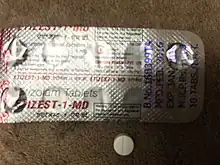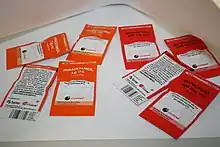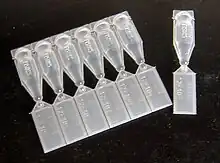Dosage form
Dosage forms (also called unit doses) are pharmaceutical drug products in the form in which they are marketed for use, with a specific mixture of active ingredients and inactive components (excipients), in a particular configuration (such as a capsule shell, for example), and apportioned into a particular dose. For example, two products may both be amoxicillin, but one is in 500 mg capsules and another is in 250 mg chewable tablets. The term unit dose can also sometimes encompass non-reusable packaging as well (especially when each drug product is individually packaged[1]), although the FDA distinguishes that by unit-dose "packaging" or "dispensing".[2] Depending on the context, multi(ple) unit dose can refer to distinct drug products packaged together, or to a single drug product containing multiple drugs and/or doses. The term dosage form can also sometimes refer only to the pharmaceutical formulation of a drug product's constituent drug substance(s) and any blends involved, without considering matters beyond that (like how it is ultimately configured as a consumable product such as a capsule, patch, etc.). Because of the somewhat vague boundaries and unclear overlap of these terms and certain variants and qualifiers within the pharmaceutical industry, caution is often advisable when conversing with someone who may be unfamiliar with another person's use of the term.
Depending on the method/route of administration, dosage forms come in several types. These include many kinds of liquid, solid, and semisolid dosage forms. Common dosage forms include pill, tablet, or capsule, drink or syrup, and natural or herbal form such as plant or food of sorts, among many others. Notably, the route of administration (ROA) for drug delivery is dependent on the dosage form of the substance in question. A liquid dosage form is the liquid form of a dose of a chemical compound used as a drug or medication intended for administration or consumption.
Various dosage forms may exist for a single particular drug, since different medical conditions can warrant different routes of administration. For example, persistent nausea, especially with vomiting, may make it difficult to use an oral dosage form, and in such a case, it may be necessary to use an alternative route such as inhalational, buccal, sublingual, nasal, suppository or parenteral instead. Additionally, a specific dosage form may be a requirement for certain kinds of drugs, as there may be issues with various factors like chemical stability or pharmacokinetics. As an example, insulin cannot be given orally because upon being administered in this manner, it is extensively metabolized in the gastrointestinal tract (GIT) before reaching the blood stream, and is thereby incapable of sufficiently reaching its therapeutic target destinations. The oral and intravenous doses of a drug such as paracetamol will differ for the same reason.[3]
Oral


- Pill, i.e. Tablet or Capsule.
- Syrups
- Specialty tablet like buccal, sublingual, or orally-disintegrating
- Thin film (e.g., Listerine Pocketpaks)
- Liquid solution or suspension (e.g., drink or syrup)
- Powder or liquid or solid crystals
- Natural or herbal plant, seed, or food of sorts (e.g., marijuana such as that found in cannabis edible)
- Pastes (e.g., Toothpaste)
- Buccal film
Ophthalmic

- Liquid solution
☆Ophthalmics☆ a)Ophthalmic solutions 1.Eye drops 2.Eye lotions b)ophthalmic suspensions c)ophthalmic ointments d)ophthalmic emulsions
Inhalation
Unintended ingredients
Talc is an excipient often used in pharmaceutical tablets. Also, illicit drugs that occur as white powder in their pure form are often cut with cheap talc. Natural talc is cheap but contains asbestos while asbestos-free talc is more expensive. Inhaled talc that has asbestos is generally accepted as being able to cause lung cancer if it is inhaled. The evidence about asbestos-free talc is less clear, according to the American Cancer Society.[4]
Injection

Unintended ingredients
Safe
Eye drops (normal saline in disposable packages) are distributed to syringe users by needle exchange programs.
Unsafe
The injection of talc from crushed pills has been associated with pulmonary talcosis in intravenous drug users.[5]
Parenteral
- Intradermal (ID)
- Subcutaneous (SC)
- Intramuscular (IM)
- Intraosseous (IO)
- Intraperitoneal (IP)
- Intravenous (IV)
Topical
- Cream, gel, liniment or balm, lotion, or ointment, etc.
- Ear drops (otic)
- Eye drops (ophthalmic)
- Skin patch (transdermal)
- Dermal patch
- Powder/Talc
Unintended use
- Medical transdermal patches. It is not safe to calculate divided doses by cutting and weighing medical patches, because there's no guarantee that the substance is evenly distributed in the drug reservoir.[6]
- Fentanyl transdermal patches are designed to slowly release the substance over 3 days. It is well known that cut fentanyl transdermal consumed orally have cause overdoses and deaths.
- Single blotting papers for illicit drugs injected from solvents in syringes may also cause uneven distribution in the drug reservoir.
Suppository
- Intravaginal
- Rectal
- Urethral
- Nasal
See also
References
- ↑ "unit dose". thefreedictionary.com.
- ↑ Affairs, Office of Regulatory. "Compliance Policy Guides - CPG Sec 430.100 Unit Dose Labeling for Solid and Liquid Oral Dosage Forms". www.fda.gov.
- ↑ "Doctors 'missed' fatal overdoses". 4 February 2011 – via www.bbc.co.uk.
- ↑ "Talcum Powder and Cancer". www.cancer.org.
- ↑ Davis, LL. (Dec 1983). "Pulmonary "mainline" granulomatosis: talcosis secondary to intravenous heroin abuse with characteristic x-ray findings of asbestosis". J Natl Med Assoc. 75 (12): 1225–8. PMC 2561715. PMID 6655726.
- ↑ https://www.pharmacytoday.org/article/S1042-0991(15)31507-3/pdf.
{{cite web}}: Missing or empty|title=(help)
External links
 Media related to Dosage forms at Wikimedia Commons
Media related to Dosage forms at Wikimedia Commons- Dosage From Development
-solution.jpg.webp)

